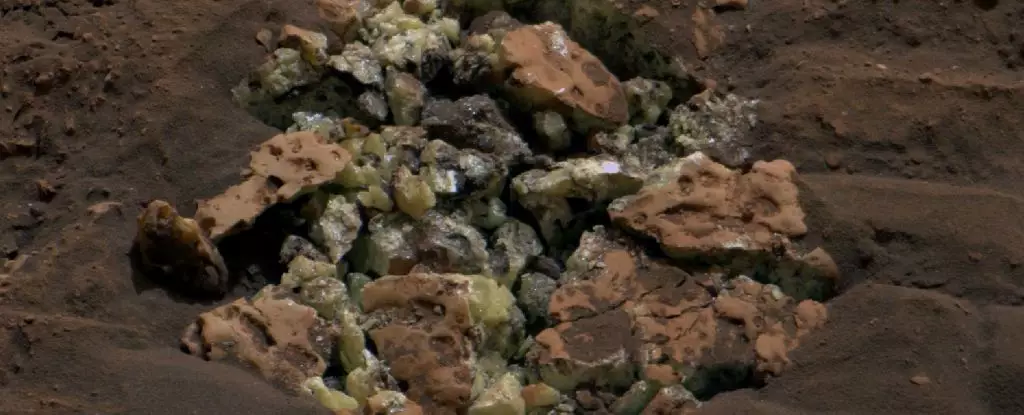In an extraordinary turn of events, NASA’s Curiosity rover made a significant geological find on Mars in May of last year—an accidental encounter that shattered the illusion of an unremarkable landscape. As the rover traversed the Martian surface, its substantial frame inadvertently broke a seemingly mundane rock, revealing an astonishing internal treasure: yellow crystals of pure elemental sulfur, or brimstone. This moment was not merely a serendipitous accident, but rather a substantial breakthrough in the quest to understand Mars’s history.
Elemental sulfur, while not entirely alien to the red planet—sulfate minerals have been detected in various locations—had never been seen in its pure form until now. This find represents a paradigm shift in our perception of Martian geology. The Gediz Vallis Channel, where Curiosity made this fortuitous discovery, is studded with rocks that appear strikingly similar to the sulfur-rich specimen, hinting at a potential abundance of this intriguing element. As project scientist Ashwin Vasavada aptly put it, the discovery of pure sulfur is akin to “finding an oasis in the desert.” The implications of this finding are profound, begging for exploration and deeper understanding of the Martian environment and its history.
Unpacking the Geological Significance
Sulfates are prevalent on Martian terrain, often indicating past interactions with water—a vital ingredient for life. They form through the evaporation of water, precipitating as salts when sulfuric compounds interact with other minerals. However, the appearance of pure sulfur raises more elusive questions about the environmental conditions on Mars. The temperatures and pressures required for the formation of elemental sulfur are not well understood in the context of the Martian surface, where liquid water survival is thought to be a rarity. Thus, these yellow crystals compel scientists to reassess existing hypotheses regarding Mars’s ancient aquatic landscapes.
The discovery of pure elemental sulfur suggests that the geological history of Mars is far more intricate than previously assumed. It forces us to entertain the possibility of unique and unexplored processes that could have enabled such a find. Delving deeper into this enigmatic formation may require sophisticated modeling and further exploration, underscoring the complexities scientists face in piecing together Mars’s past while navigating the limitations of terrestrial understanding.
Implications for the Search for Life
While the presence of sulfur alone is not direct evidence of life, it opens up fascinating avenues of exploration. Sulfur is critical for life as we know it, serving as a building block for essential amino acids found in proteins. This fact positions sulfur as a key player in biological systems, raising questions about the potential for life, past or present, on the red planet. Even though so far we have not yet discovered definitive signs of life, the ongoing retrieval of chemistry conducive to life raises hopes. These discoveries illustrate that conditions might have once favored life or could still do so in some capacity.
This conversation also underscores the reality that while we are limited in our exploration capabilities from Earth, opportunities presented by rovers like Curiosity have opened windows into understanding Mars’s geology and history. The capability of these instruments to analyze Martian materials from afar is a testament to human ingenuity and our relentless search for knowledge about other worlds.
A Journey of Discovery Continues
As Curiosity continues its journey through the Gediz Vallis Channel, it serves as a relentless sentinel navigating through an ancient landscape, once traversed by flowing water, now offering glimpses into a time long past. The rover has already collected samples that promise to reveal further insights into the channel’s geological and hydrological history. The future steps involve not only potential new discoveries but also a need to harness the knowledge gleaned from the elemental sulfur—to piece together the puzzle of Mars in a greater context.
Curiosity’s mission represents more than a lone quest; it is a woven tapestry of scientific exploration, revealing rays of possibility in the dark unknowns of our cosmic neighbors. Each cracked rock and sampled mineral serves to ignite the imagination of both scientists and the public, fueling our shared desire to understand our universe’s intricacies. As we inch closer to revealing the mysteries of Mars, we are left with the exhilaration of awaiting what other surprises lie hidden beneath the surface, just waiting for the right moment to be uncovered.

